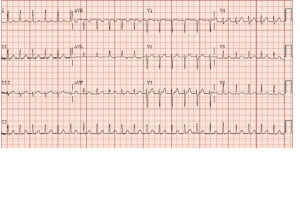80 yo F presents with intermittent palpitations associated with shortness of breath but is otherwise stable.
What is your differential for this rhythm?
How do you treat it?
Best answer by Friday will win!
The views expressed on this blog are the author's own and do not reflect the views of their employer. Please read our full disclaimer here. Any references to clinical cases refer to patients treated at a virtual hospital, Janus General Hospital.
The following two tabs change content below.


eabram
Latest posts by eabram (see all)
- Rhythm Nation May 2015 Answer! - June 1, 2015
- Rhythm Nation May 2015 - May 10, 2015
- Rhythm Nation April 2015 – Answer! - April 20, 2015
- Rhythm Nation April 2015 - April 13, 2015
- Rhythm Nation March 2015 – Answer! - March 31, 2015


-The EKG looks fast (about 140-150), regular, narrow, and I don’t see normal P waves before the QRS.
-It looks like supraventricular tachycardia, likely AVNRT but differential includes AVRT. Within AVNRT, it could be slow-fast/orthodromic (most common) or fast-slow/antidromic. I think this is antidromic because I see a retrograde P wave after the QRS in many of the leads, whereas in orthodromic the P-waves are hidden in the QRS.
-Treatment depends on her vitals. If she is stable as mentioned, you can first try vagal maneuvers, and then move to adenosine (6mg quick IVP, then 12mg if needed). You could also try calcium channel blockers (diltiazem 20mg) or beta blockers (esmolol 500mcg/kg IV or metoprolol 5mg IV).
If she is unstable, you should synchronized cardiovert her with 50-100 J.
The deferrential dx for regular narrow complex tachycardia with rate 150 are: atrial flutter, SVT, sinus tachy, accelerated junctional tachycardia.
I think the patient has AVNRT with rate more than 140 and No P wave .
Managment adenosine.
I think junctional tachycardia is highly possible